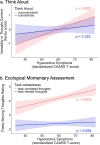Hyperactive ADHD symptoms are associated with increased variability in thought content in less constrained contexts
- PMID: 40118952
- PMCID: PMC11928452
- DOI: 10.1038/s41598-025-93053-x
Hyperactive ADHD symptoms are associated with increased variability in thought content in less constrained contexts
Abstract
The current study used two complementary methods to examine whether hyperactive and inattentive ADHD symptoms are differentially linked to thought dynamics under contexts that differ in the extent to which constraints are placed on ongoing thoughts. First, participants voiced aloud their thoughts in real-time (i.e., Think Aloud task), under two conditions varying in the levels of constraints exerted on their thoughts. Individuals with more hyperactive symptoms displayed heightened variability in thought content only in the less constrained condition. Second, participants completed seven days of ecological momentary assessment during which they received six thought probes daily asking the extent to which their thoughts were freely moving (as a proxy for thought content variability) and a question that captured different levels of constraints. Hyperactive symptoms were positively associated with freely moving thoughts only during responses that corresponded with lower levels of constraints. Across two approaches, we provide converging evidence that hyperactive, but not inattentive, ADHD symptoms are associated with increased thought content variability during lower levels of deliberate constraints on thoughts. Together, these results support the Dynamic Framework of Spontaneous Thought and highlight the importance of considering context in the study of thought dynamics in ADHD.
Keywords: ADHD; Ecological momentary assessment; Mind wandering; Spontaneous thought; Think aloud; Thought dynamics.
© 2025. The Author(s).
Conflict of interest statement
Declarations. Competing interests: The authors declare no competing interests.
Figures


References
-
- Raffaelli, Q. et al. The think aloud paradigm reveals differences in the content, dynamics and conceptual scope of resting state thought in trait brooding. Sci. Rep.11, 19362 (2021). https://doi.org/10.1038/s41598-021-98138-x - PMC - PubMed
-
- Christoff, K., Irving, Z. C., Fox, K. C. R., Spreng, R. N. & Andrews-Hanna, J. R. Mind-wandering as spontaneous thought: A dynamic framework. Nat. Rev. Neurosci.17, 718–731 (2016). - PubMed
-
- Faraone, S. V. et al. Attention-deficit/hyperactivity disorder. Nat. Rev. Dis. Primers1, 1-23 (2015).
MeSH terms
Grants and funding
LinkOut - more resources
Full Text Sources
Medical

